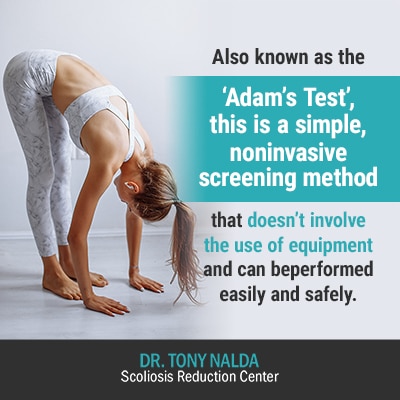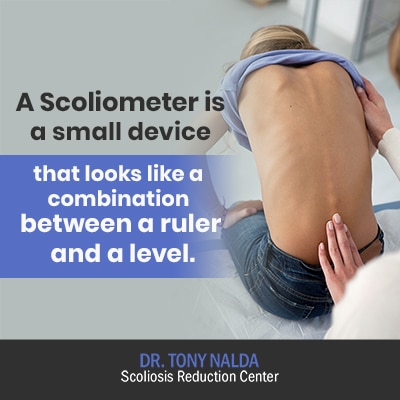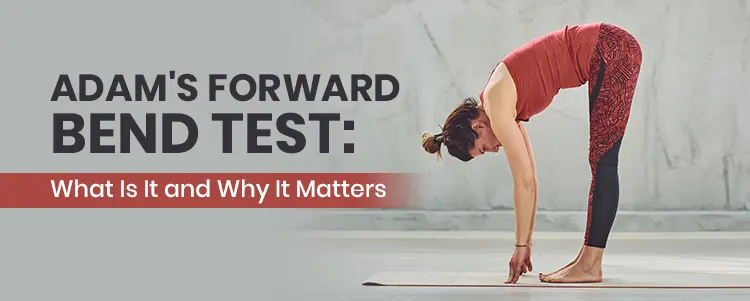One of the challenging aspects of scoliosis is how difficult it can be to diagnose the condition in its early days. As a scoliosis specialist, I’m trained to notice even the subtlest signs of scoliosis, but this is not something an average person will likely be able to do. Fortunately, tests such as the Adam’s forward bend test can help.
The Adam’s forward bend test is a simple and non-invasive screening exam that can effectively detect the presence of indicators for scoliosis. This is highly advantageous as there are numerous benefits to early detection in terms of treatment efficacy. These types of screening tests are invaluable as they can lead to a diagnosis that might not otherwise be reached.
Before we start talking about the specifics of the Adam’s forward bend test, let’s first talk about why early detection can be such a challenge in the condition’s most common form: adolescent idiopathic scoliosis.
Adolescent Idiopathic Scoliosis
While scoliosis can develop at any age, it most commonly affects adolescents between the ages of 10 and 18 and is diagnosed as adolescent idiopathic scoliosis (AIS).
The ‘idiopathic’ designation means there is not a single-known cause for its development and is, instead, considered to be multifactorial.
AIS cases account for approximately 80 percent of known diagnosed cases; the other 20 percent have known causes and include neurological, congenital, degenerative, and traumatic scoliosis
When it comes to AIS, this is the most prevalent form of scoliosis, and as a progressive condition, we know that it’s going to get worse over time.
The key is to try and catch the condition early on before the abnormal spinal curvature gets larger and more difficult to treat.
While it might seem as though it would be easy to notice an abnormal spinal curvature developing in a loved one or yourself, that is not always the case.
Now that we’ve touched on the prevalence of AIS and its progressive nature, let’s address why early detection is not always easily achieved.
Early Detection
When it comes to AIS, we are talking about adolescents and teenagers: a group not exactly known for their compliance and transparency.
By the time a child reaches adolescence, chances are their parents and/or caregivers haven’t bathed them in a while. It becomes less common to see children of this age without their shirts on, and this makes it harder to notice an abnormality of the spine.
In addition, if an adolescent or teenager were to actually notice some subtle changes to their body or the way they walk, they might not always share their findings.
They might be shy and not want to draw attention to themselves. Children of this age generally just want to fit in. It’s not uncommon for teenagers to make active efforts to hide scoliosis-related changes, and they can get remarkably good at doing it.
Baggy black clothes and hoodies are particularly effective at concealing the body and any asymmetries present.
The truth is if a teenager doesn’t want their parents and/or caregivers to know how their body might be changing due to scoliosis, they will likely succeed.
I often hear that it wasn’t until a family beach vacation when parents saw their teenager in a bathing suit that they noticed an apparent asymmetry such as uneven shoulders, one shoulder blade protruding more than the other, a rib arch, or a crooked spine.
In addition, AIS is rarely a painful condition. This is because as they have not yet reached skeletal maturity, their spines are always lengthening, and this counteracts the compressive force of an abnormal spinal curvature.
Without pain as an indicator that something is amiss in the body, it’s even harder to know scoliosis is present. Also, mild forms of the condition rarely cause functional deficits.
The other factor that greatly impacts early detection is condition severity. When a person gets a scoliosis diagnosis, their condition is further classified based on a number of patient and condition characteristics; one such characteristic is condition severity.
Condition severity is determined by the patient’s Cobb angle, which is a measurement obtained via X-ray that measures the most-tilted vertebrae of the curvature. Intersecting lines are drawn from the tops and bottoms of these vertebrae, and the resulting angle tells us how far out of a natural alignment the scoliotic spine is.
The higher the Cobb angle, the more severe the condition is, and the more likely it is to produce noticeable symptoms:
- Mild scoliosis – Cobb angle measurement of between 10 and 25 degrees
- Moderate scoliosis – Cobb angle measurement of between 25 and 40 degrees
- Severe scoliosis – Cobb angle measurement of 40+ degrees
Just based on the different Cobb angle measurements of each severity level, you can see how much of a range the condition has. Scoliosis can start as low as 10 degrees and go all the way up into the hundreds.
Just to give you an even better idea of the range, the largest curvature I’ve seen is a 150-degree curve, so imagine the difference between a 10-degree and a 150-degree curvature.
In mild forms, and even some moderate ones, if the condition is not painful, doesn’t produce noticeable functional deficits, and its postural changes are subtle and go unnoticed, you can see how hard early detection can be.
Fortunately, there are early screening tests that can be done, such as the ‘Adam’s forward bend test’, that can help detect the early signs of the condition.
What is an Adam’s Forward Bend Test?

Also known as the ‘Adam’s Test’, this is a simple, noninvasive screening method that doesn’t involve the use of equipment and can be performed easily and safely.
The Adam’s test is a standard screening test for medical professionals, and for parents and/or caregivers of adolescents who are concerned scoliosis might be an issue, a trip to see your health-care provider, who can easily perform the screening test, can help get you the answers you’re looking for.
When done properly, the Adam’s test can be a valuable screening tool for possible indicators of scoliosis.
To do this, the potential patient would stand up straight with arms flat at their sides. Then they would bend forward at a 90-degree angle with their arms hanging down as if they are trying to touch their toes.
As mentioned earlier, in mild scoliosis, often the signs are not visible to someone who is not trained in precisely what to look for, and this is why the Adam’s test can be so helpful; in this position, the spine is far more visible and easier to see an abnormality.
It also makes it much easier to see other asymmetries caused by scoliosis, such as uneven shoulders, shoulder blades, hips, and the characteristic rib arch. Rib arches are generally more prominent on the right side because this is where the majority of children develop scoliosis.
The Adam’s test can tell us where along the spine the curvature is, and when combined with a scoliometer, its results are even more reliable.
What is a Scoliometer?

A scoliometer is a small device that looks like a combination between a ruler and a level. It has a notched-out portion in its center where it is placed over the spine.
There is a bubble inside the scoliometer that lines up with a corresponding measurement in degrees. The scoliometer is slid up and down the spine to measure trunk asymmetry. The reading shows the degree of tilt in the area of the curvature.
While the Adam’s forward bend test is not a diagnostic tool, it is an effective screening method for indicating whether or not a person should go for further testing.
If the bubble in the device aligns with 7 degrees, this equals around a 20-degree measurement on an X-ray.
When the Adam’s forward bend test is combined with the use of a scoliometer, this makes the Adam’s test even more informative and is an accepted method used to screen for indicators of scoliosis.
Keeping in mind the challenge and importance of early detection, you can see how beneficial an exam of this nature can be for parents and/or caregivers of adolescents who might be tempted to hide any noticeable changes.
Conclusion
As scoliosis is a progressive condition, it’s particularly beneficial to reach a diagnosis as early as possible in the condition’s progressive line. This is so that treatment can be started before the patient has experienced significant progression and their body has already started to adjust to the curvature.
The sooner treatment is started, the better the chances are for treatment success. We want to help our patients avoid reaching the hardships of more severe levels of their condition, and treatment started early can be a big part of that.
Although an Adam’s forward bend test can’t replace the role of the X-ray in assessing the condition and obtaining precise curvature measurements, it is a valuable method for determining if an individual is in need of further testing.
When it comes to the condition’s most common form (AIS), the absence of pain, the subtlety of postural changes, and the tendency of adolescents and teenagers to not always share what’s happening to their bodies makes early detection particularly challenging.
As adolescents and teenagers are entering into, or are in, the stage of puberty, they are going to go through rapid and unpredictable growth spurts. As we know that growth is the condition’s number one trigger for progression, they are likely to experience progression at unpredictable rates; this is another reason that early detection of scoliosis in the age group of patients between 10 and 18 is so important.
In instances where an adolescent’s condition is mild and not producing noticeable postural changes, or where the patient might be tempted to conceal those changes out of embarrassment, an Adam’s forward bend test, combined with a scoliometer, is a safe, noninvasive, and informative means of determining if there is further cause for concern.
Here at the Scoliosis Reduction Center®, we encourage all parents and/or caregivers to take a proactive approach with their adolescents when it comes to scoliosis, and part of that is knowing that there are early screening tests available that can lead to answers.
The benefits of early detection are too important to overlook, so if you have concerns and would like to have an Adam’s forward bend test performed on yourself or a loved one, don’t hesitate to reach out for further answers and guidance.





